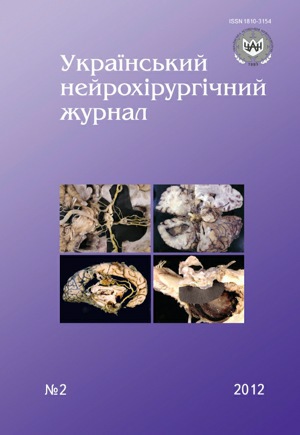The experimental study of metformin’s antitumor action in rats with brain glioma
DOI:
https://doi.org/10.25305/unj.59044Keywords:
brain glioma, metformin, cisplatin, doxorubicin, experimentAbstract
Introduction. Metformin, known as medicine for diabetes mellitus treatment, today is widely studied in oncology as drug for suppressing growth of different malignant tumors in experiments on animals.
Materials and methods. Metformin’s untitumor effect was studied on rats with glioma 101.8, treated with metformin or it’s combination with chemomedicines cisplatin or doxorubicin. The duration of animals’ life with brain glioma and it’s average rate in each group of rats were determined.
Results. The direct and combined influence of metformin on rats’ brain tumor was studied in experiment. It was determined that metformin in doses 50–150 mg/kg not influence on the growth of brain glioma. Metformin an injection with cisplatin or doxorubicin more often suppressed glioma’s growth then used separately.
Conclusion. On the base of experiments’ results analysis the use of metformin is recommended in neurooncology clinic during malignant gliomas treatment.
References
1. Dowling R, Zakikhani M, Fantus I, Pollak M, Sonenberg N. Metformin Inhibits Mammalian Target of Rapamycin Dependent Translation Initiation in Breast Cancer Cells. Cancer Research. 2007;67(22):10804-10812. [CrossRef] [PubMed]
2. Zakikhani M, Dowling R, Fantus I, Sonenberg N, Pollak M. Metformin Is an AMP Kinase-Dependent Growth Inhibitor for Breast Cancer Cells. Cancer Research. 2006;66(21):10269-10273. [CrossRef] [PubMed]
3. Sahra I, Laurent K, Loubat A et al. The antidiabetic drug metformin exerts an antitumoral effect in vitro and in vivo through a decrease of cyclin D1 level. Oncogene. 2008;27(25):3576-3586. [CrossRef] [PubMed]
4. Buzzai M, Jones R, Amaravadi R et al. Systemic Treatment with the Antidiabetic Drug Metformin Selectively Impairs p53-Deficient Tumor Cell Growth. Cancer Research. 2007;67(14):6745-6752. [CrossRef] [PubMed]
5. Isakovic A, Harhaji L, Stevanovic D et al. Dual antiglioma action of metformin: cell cycle arrest and mitochondria-dependent apoptosis. Cell Mol Life Sci. 2007;64(10):1290-1302. [CrossRef] [PubMed]
6. Gotlieb W, Saumet J, Beauchamp M et al. In vitro metformin anti-neoplastic activity in epithelial ovarian cancer. Gynecologic Oncology. 2008;110(2):246-250. [CrossRef] [PubMed]
7. Hirsch H, Iliopoulos D, Tsichlis P, Struhl K. Metformin Selectively Targets Cancer Stem Cells, and Acts Together with Chemotherapy to Block Tumor Growth and Prolong Remission. Cancer Research. 2009;69(19):7507-7511. [CrossRef] [PubMed]
8. Liu B, Fan Z, Edgerton S et al. Metformin induces unique biological and molecular responses in triple negative breast cancer cells. Cell Cycle. 2009;8(13):2031-2040. [CrossRef] [PubMed]
9. Dowling R, Goodwin P, Stambolic V. Understanding the benefit of metformin use in cancer treatment. BMC Medicine. 2011;9(1):33. [CrossRef] [PubMed]
10. Belfiore A, Frasca F. IGF and Insulin Receptor Signaling in Breast Cancer. J Mammary Gland Biol Neoplasia. 2008;13(4):381-406. [CrossRef] [PubMed]
11. Saydah S. Abnormal Glucose Tolerance and the Risk of Cancer Death in the United States. American Journal of Epidemiology. 2003;157(12):1092-1100. [CrossRef] [PubMed]
12. Lipscombe L, Goodwin P, Zinman B, McLaughlin J, Hux J. Diabetes mellitus and breast cancer: a retrospective population-based cohort study. Breast Cancer Res Treat. 2006;98(3):349-356. [CrossRef] [PubMed]
13. Soritau O, Tomuleasa C, Aldea M, Petrushev B, Susman S, Gheban D, Ioani H, Cosis A, Brie I, Irimie A, Kacso G, Florian IS. Metformin plus temozolomide-based chemotherapy as adjuvant treatment for WHO grade III and IV malignant gliomas. J BUON. 2011 Apr-Jun;16(2):282-9. [PubMed]
14. Lisianyi N, Belska L, Klyuchnikova A. Іmmunomodulаtive and antitumor effect of celandine’s preparations on brain tumors. Ukrainian Neurosurgical Journal. 2011;(1):23-29. Ukrainian. [Abstract/Full Text]
15. Ben Sahra I, Le Marchand-Brustel Y, Tanti J, Bost F. Metformin in Cancer Therapy: A New Perspective for an Old Antidiabetic Drug?. Molecular Cancer Therapeutics. 2010;9(5):1092-1099. [CrossRef] [PubMed]
Downloads
Published
How to Cite
Issue
Section
License
Copyright (c) 2012 Nikolay Lisianyi, Antonina Klyuchnikova, Oleksandr Lisianyi, Vera Semenova, Lyudmila Belska

This work is licensed under a Creative Commons Attribution 4.0 International License.
Ukrainian Neurosurgical Journal abides by the CREATIVE COMMONS copyright rights and permissions for open access journals.
Authors, who are published in this Journal, agree to the following conditions:
1. The authors reserve the right to authorship of the work and pass the first publication right of this work to the Journal under the terms of Creative Commons Attribution License, which allows others to freely distribute the published research with the obligatory reference to the authors of the original work and the first publication of the work in this Journal.
2. The authors have the right to conclude separate supplement agreements that relate to non-exclusive work distribution in the form of which it has been published by the Journal (for example, to upload the work to the online storage of the Journal or publish it as part of a monograph), provided that the reference to the first publication of the work in this Journal is included.









